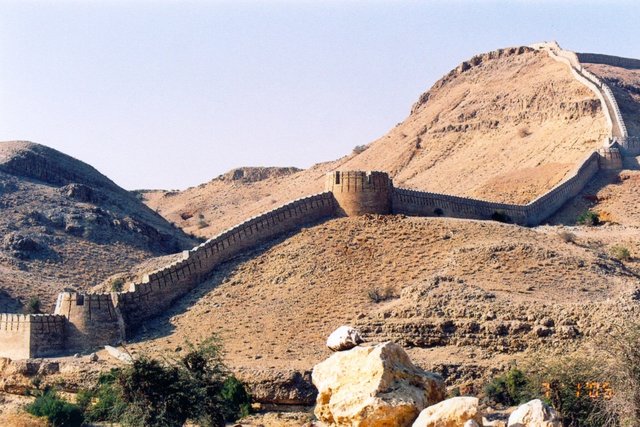Ranikot Fort (Sindhi: رني ڪوٽ, Urdu: قلعہ رانی کوٹ) is a historical fort near Sann, Jamshoro District, Sindh, Pakistan.Ranikot Fort is also known as The Great Wall of Sindh سنڌ جي عظيم ديوار and is believed to be the world's largest fort.[2][3] with a circumference of approximately 26 kilometres (16 mi). The fort's ramparts have been compared to the Great Wall of China.
The site was nominated in 1993 by the Pakistan National Commission for UNESCO world heritage status, and has since been on the tentative list of UNESCO World Heritage Sites. The fort is listed as a historical site under the Antiquities Act, 1975 and its subsequent amendments, and is provided protection.
Ranikot Fort is 90 kilometres (56 mi) to the north of Hyderabad on the national highway. There is also an easy access of about an hour's journey from Karachi to Sann on the Indus Highway. A diversion road, starting a little distance away from Sann, the nearest town, leads to the fort along a rugged 21 kilometres (13 mi) road and reaches the eastern gate of the fort, known as Sann Gate. Sann is a rail head on the Kotri-Larkana line of the Pakistan Railway.It[clarification needed] is inside the Kirthar National Park, the second largest national park in Pakistan.Thanks For Reading :)
Photo by Aziz Ali Photographer

History
The original purpose and architects of Ranikot Fort are unknown. However, it is believed that the fort was built during the regimes of the Sassanians, the Scythians, the Parthians or the Bactrian Greeks. Archaeologists point to the 17th century as the time of its first construction but Sindh archaeologists now agree that some of the present structures were reconstructed by Talpurs in 1812 at a cost of 1.2 million rupees (Sindh Gazetteer, 677). The battlements of Ranikot formed the last capital of the Amirs of Sind, when they were brought under the colonial rule of the British Empire. Radiocarbon tests were conducted at the Sann Gate on the charcoal embedded in the mortar of a collapsed pillar of the eastern gate of the fort. These tests have confirmed that this gate was probably renovated between the early part of the 18th century and the early part of the 19th century, prior to Britain invading the fort when the Kalhoras, or most likely the Talpur Mirs of Sindh ruled over the area.

Follow Me upvote Resteem

Heyy really nice post:) It was verry useful.Please check my little journey that I made soon. I hope you enjoy my photos. @nakedchef89
https://steemit.com/history/@nakedchef89/what-is-the-oldest-civilization-on-earth
Downvoting a post can decrease pending rewards and make it less visible. Common reasons:
Submit